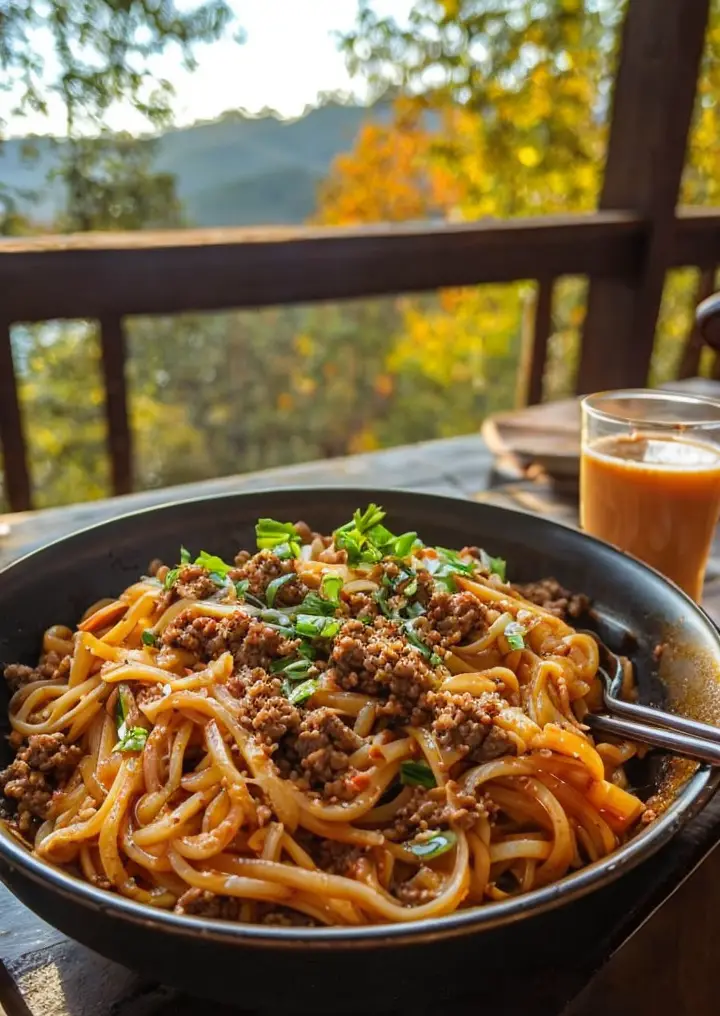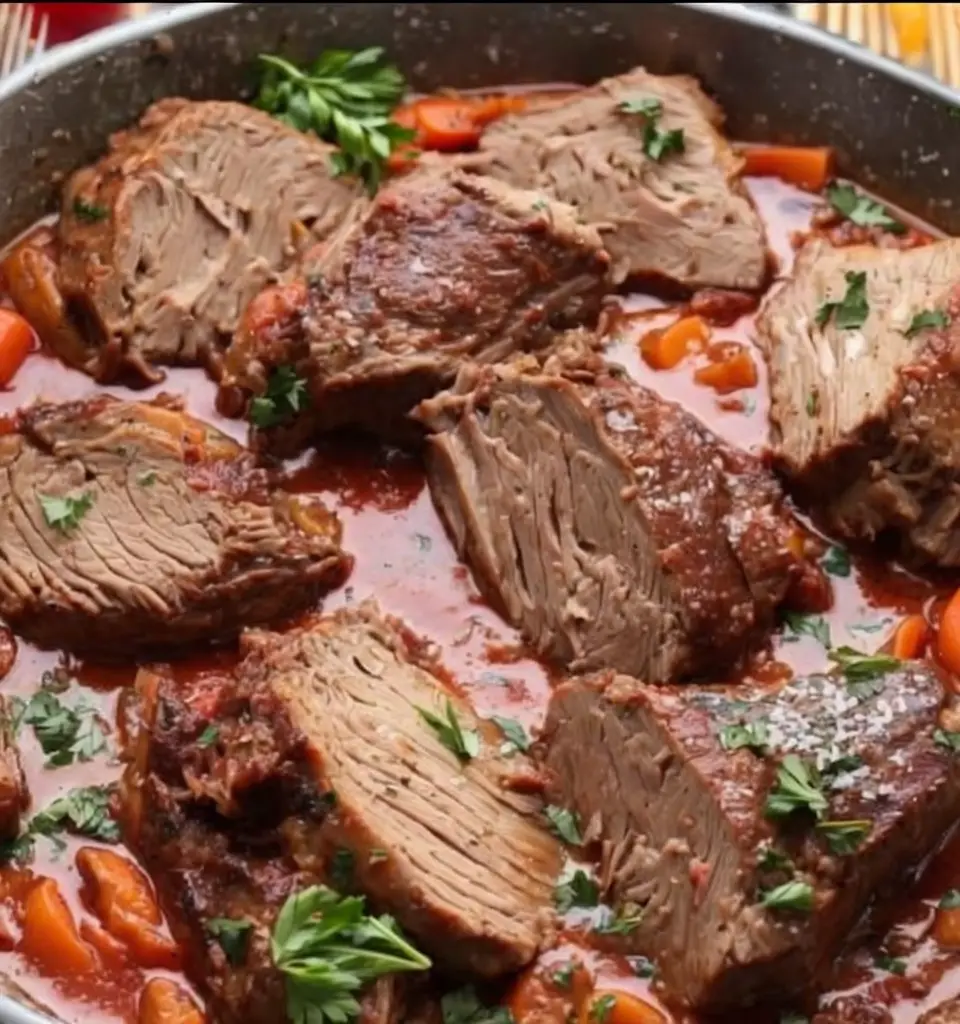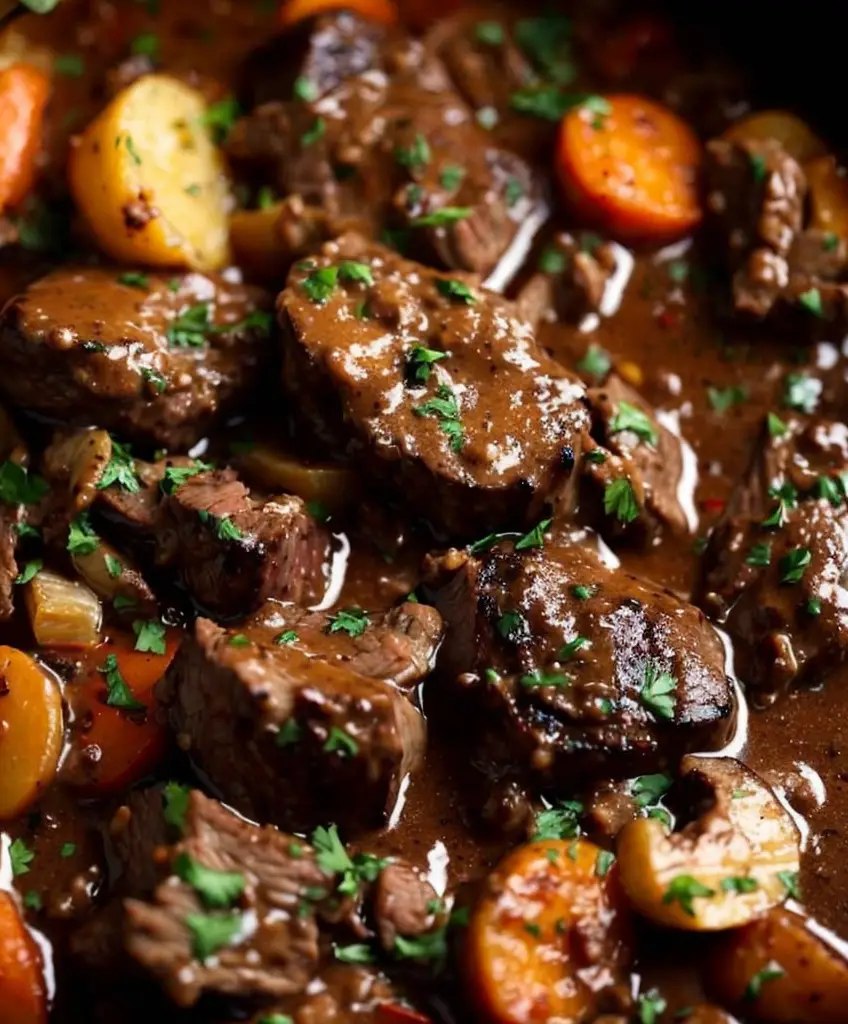Mongolian Noodles with Ground Beef: A Flavorful Twist on a Classic Family Dish
Mongolian Noodles with Ground Beef is an irresistible dish that combines savory flavors with a satisfying texture. It’s a vibrant and hearty meal that can transform any weeknight dinner into a special occasion. The tender ground beef is richly seasoned and paired with colorful vegetables, creating a delightful medley. This recipe beautifully illustrates how simple ingredients can pack a flavor punch, making it an excellent choice for families and entertaining guests.
The moments spent in the kitchen preparing this dish are sure to be filled with excitement as the aromas fill your home. The stir-frying process creates a wonderful balance of tenderness and a slight crisp, enhancing the dish’s appeal. Topped with fresh herbs, you will feel an instant sense of comfort and gratification. Whether you are catering to children or culinary enthusiasts, Mongolian Noodles will surely please everyone at the table.
Quick Recipe Highlights
- Flavor Profile: A harmonious balance of umami from the beef combined with the sweetness of the vegetables.
- Texture: Each bite offers a delightful chewiness from the noodles and a satisfying crunch from fresh vegetables.
- Aroma: Inviting scents of garlic and ginger mingle with savory soy sauce will awaken your senses.
- Visual Appeal: Bright, colorful veggies contrast beautifully against the golden noodles, making for an attractive presentation.
- Skill Level Needed: Perfect for novice cooks; no special skills are needed, just basic cooking techniques.
- Special Equipment: Only requires a large skillet or wok for efficient cooking.
Recipe Overview
- Difficulty Level: Easy, great for beginners looking to enhance their cooking skills with quick, flavorful dishes.
- Category: Perfect for weeknight dinners, potlucks, or when you want a warm, comforting meal.
- Cuisine: Inspired by Mongolian flavors, this dish brings an Asian twist to pasta concepts.
- Cost: Approximately $15 for a full meal, making it budget-friendly while still being delicious.
- Season: Enjoyable year-round, with the ability to adapt ingredients based on seasonal produce.
- Occasion: Excellent for family dinners, gatherings with friends, or when you need a quick but impressive meal.
Why You’ll Love This Recipe
The union of flavors in this Mongolian Noodles recipe will leave a lasting impression on your taste buds. The beef’s rich umami couples perfectly with the crispness of the greens, creating a distinctive taste that is comforting yet exciting. With a blend of soy sauce and sesame oil, each bite bursts with depth, making it a delightful experience for every palate. It’s easy to see why this dish becomes a go-to for many families.
Convenience is another standout aspect of this recipe. With minimal prep time and straightforward cooking steps, you can quickly whip together a wholesome meal even on the busiest days. The one-pan method makes for a quick cleanup, allowing you to focus on what really matters—enjoying your meal and spending time with loved ones.
From a nutritional standpoint, Mongolian Noodles deliver a balanced profile with protein from the beef and an array of vitamins from the vegetables. This dish allows you to pack a variety of nutritious ingredients into one meal, ensuring that you’re nourishing your body without sacrificing flavor or enjoyment.
This recipe also holds a social aspect; it’s perfect for sharing and feeding larger groups. The bright colors and enticing aroma generate excitement around the dinner table, making it a centerpiece for family gatherings or casual dinner parties. Gathering around a hot plate of Mongolian Noodles encourages connection and conversation, fostering lasting memories.
Finally, cost-effectiveness makes this recipe a win. Using readily available ingredients, it is both affordable and satisfying. You can enjoy a gourmet-quality meal without breaking the bank, making it an invaluable addition to your weekly meal plans.
Historical Background and Cultural Significance
Mongolian cuisine often pays homage to its nomadic origins, characterized by hearty, meat-based dishes. This recipe, although influenced by American perceptions of Mongolian flavors, captures the spirit of robust, comforting meals common to the region. The introduction of noodles serves as a creative adaptation that bridges cultural cuisines.
Traditionally, Mongolian dishes emphasize meat, particularly from livestock, reflecting environmental realities. In contrast, this recipe incorporates noodles, offering a modern twist while still respecting its cultural roots. The blend of ingredients signifies adaptability, showcasing how traditional flavors can evolve over time.
As global influences take hold of culinary traditions, this dish highlights the fusion that defines contemporary cooking. The evolution from a simple meat-centric meal to one that includes vibrant vegetables and sauces embodies the impact of cross-cultural culinary exchange.
Regional variations continue to flourish, drawing upon local ingredients and preferences. While this recipe remains accessible and versatile, variations can include different proteins or vegetables, allowing cooks to personalize their version while paying homage to its roots.
Ingredient Deep Dive
Ground Beef
Ground beef is a staple in many kitchens worldwide and brings not only flavor but substance to dishes. It is rich in protein, vitamins, and iron, vital for energy and overall health. When selecting ground beef, look for meat with a good fat-to-lean ratio to enhance your dish’s flavor without overwhelming it with grease. Proper storage includes keeping it in the refrigerator for 1-2 days post-purchase or freezing for later use. Additionally, if you prefer a leaner option or are exploring dietary modifications, ground turkey or lentils can serve as excellent substitutes.
Vegetables
Fresh vegetables not only add color but also offer a window into nutritional diversity. Including bell peppers, carrots, and broccoli enhances the dish’s texture, flavor, and nutritional profile. These veggies are rich in vitamins A and C and offer dietary fiber, essential for digestion. Choose crisp, vibrant-skinned vegetables and store them in a cool place to maintain freshness. For a seasonal twist, consider substituting in squash in the autumn or snap peas in the spring for a delicious variation.
Common Mistakes to Avoid
- Overcooking the beef can lead to a dry texture. Keep an eye on it and cook just until browned.
- Using low-quality noodles can result in a mushy dish. Opt for fresh or high-quality noodles for the best results.
- Skipping the marination for your ingredients can dampen the flavor. Take the time to let everything soak in the seasonings.
- Not prepping ingredients beforehand leads to rushed cooking. Measure and chop everything before you start cooking.
- Overcrowding the skillet can steam rather than stir-fry your ingredients. Cook in batches if necessary for proper browning.
- Neglecting to taste as you cook prevents achieving a well-balanced flavor profile. Adjust seasonings as needed for your palate.
- Forgetting to add an acid, like lime juice or vinegar, can make the dish taste flat. A touch of acidity brightens flavors significantly.
- Failing to garnish can result in an uninspired dish. Fresh herbs or sesame seeds add texture and enhance presentation.
Essential Techniques
Stir-Frying
Stir-frying is a quick cooking method that requires high heat and minimal oil. It involves rapidly cooking ingredients in a wok or large pan, preserving both flavor and texture. To master stir-frying, ensure your ingredients are uniformly cut for even cooking. Use high heat to achieve a delightful sear but watch them closely to avoid burning. A well-stir-fried dish should have a vibrant color with a slightly caramelized surface.
Balancing Flavors
Understanding how to balance flavors is essential for a delicious dish. This involves combining salty, sweet, sour, and bitter elements to create a harmonious taste. To master this skill, start by tasting your dish as you cook and adjusting seasonings accordingly. If a dish feels too salty, add a touch of sweetness or acidity to counterbalance it. Paying attention to how these elements interact will elevate your cooking and turn ordinary meals into extraordinary ones.
Pro Tips for Perfect Mongolian Noodles
1. Use high-quality, fresh noodles for a chewy texture and quick cooking time.
2. Let the ground beef marinate for at least 15 minutes to absorb the flavors.
3. Adjust the spice level by adding chili sauce or crushed red pepper for heat.
4. Incorporate a variety of vegetables to enhance flavor and nutrition.
5. Keep the wok or pan hot to achieve the best sear and prevent sticking.
6. Always taste and adjust seasoning during the cooking process for a balanced flavor.
7. Don’t rush the cooking of your vegetables; allow them to soften slightly for full flavor.
8. Serve immediately to enjoy the best texture and flavor; this dish is best eaten fresh.
Variations and Adaptations
Incorporating regional flavors can turn your Mongolian Noodles into a unique dish. For instance, using kimchi instead of fresh veggies introduces a spicy, fermented element. Alternatively, consider a seasonal adaptation by including sautéed squash during fall or asparagus in spring for variety. If you have dietary restrictions, gluten-free soy sauce can replace regular soy sauce for a suitable variation. Experimenting with different proteins like tofu or shrimp gives a new texture, while cashews or peanuts can provide delightful crunch and added richness.
Serving and Presentation Guide
Plating your Mongolian Noodles is a chance to impress! Start with a mound of noodles at the center of the plate, arranging the vegetables and beef at the top or around the side. Garnish with fresh herbs like cilantro or scallions for a pop of color. A drizzle of sesame oil enhances richness and provides a visual cue of flavor. Serving in a warm bowl keeps everything cozy and appetizing, while appropriate portion sizes ensure satisfaction without overload.
Wine and Beverage Pairing
Wines that complement the robust flavors of Mongolian Noodles include a light-bodied red such as Pinot Noir, which balances the beef’s richness while enhancing the spices. Alternatively, a crisp white wine like Sauvignon Blanc can cut through the dish’s savory elements, providing a refreshing contrast. For non-alcoholic options, consider pairing with a chilled ginger ale or sparkling water with a slice of lime, enhancing the meal’s vibrant flavors.
Storage and Shelf Life
To store leftover Mongolian Noodles, transfer them to an airtight container and refrigerate for up to three days. When reheating, use a skillet over low heat to avoid overcooking. If you plan to store them for a longer period, freezing them is an option, ensuring they are well-sealed; they can last for up to three months. Signs of spoilage include an off smell or discoloration, so always check before serving. Enjoy leftovers as a quick lunch or dinner option, saving time and minimizing waste.
Make Ahead Strategies
Preparing Mongolian Noodles in advance is easy. You can chop vegetables and marinate the meat a day ahead, storing them separately in the refrigerator for maximum freshness. Noodles can also be cooked and set aside, ready to be added later. When you’re ready to assemble, heat the ingredients in a skillet, toss with the noodles, and your meal is ready. Always leave finishing touches like fresh herbs and garnishes until the last minute for the best appearance and flavor.
Scaling Instructions
Scaling this recipe is straightforward. To halve the ingredients, reduce each measurement by 50%. When doubling, make sure your skillet is large enough to accommodate the increase in volume; you may need to cook in batches. Pay close attention to cooking times, as larger quantities may require a few additional minutes, especially when simmering. If you enjoy serving a crowd, prepping extra servings allows you to stretch your culinary skills without compromising flavor.
Nutritional Deep Dive
Mongolian Noodles provide a balanced macronutrient profile, with a good mix of carbohydrates, protein, and healthy fats. The noodles serve as an excellent source of energy, while ground beef contributes valuable protein necessary for muscle repair and growth. Additionally, the inclusion of vegetables boosts micronutrient intake, providing key vitamins and minerals. With a focus on whole ingredients, this dish can fit into various dietary plans, helping with weight management.
Dietary Adaptations
For those requiring gluten-free options, substitute standard noodles with rice noodles or spiralized vegetables. To make the recipe dairy-free, ensure that sauces used do not include any dairy products. Vegan versions can utilize crumbled tofu in place of beef, pairing it with a mix of mushrooms for an umami flavor. Low-carb variations can involve using shirataki noodles or cauliflower rice, while still enjoying all the delightful flavors without excess carbohydrates.
Troubleshooting Guide
If your noodles come out mushy, ensure you’re not overcooking them. Check the package instructions for optimal cooking times. Seasoning too little can lead to blandness; taste as you go to find the right balance of flavors. If the dish seems greasy, consider using leaner meat or draining excess oil. Failed flavor adjustment can be fixed by incorporating a splash of soy sauce or a touch of sugar to complement savory elements. Keep an eye on cooking times for vegetables to ensure they’re tender-crisp but not overdone.
Recipe Success Stories
Readers have shared numerous positive experiences with this Mongolian Noodles recipe, noting how it quickly became a family favorite. Variations, like adding different proteins or vegetables, allowed them to make it their own while retaining core flavors. Photos shared in online forums showcase vibrant colors and appetizing presentations, inspiring others to give it a try. The overall feedback emphasizes convenience and taste, proving that this dish resonates with home cooks seeking satisfying and easy meal options.
Frequently Asked Questions
Can I use other proteins instead of ground beef?
Absolutely! You can use ground turkey, chicken, or even plant-based proteins like lentils or tofu. Each will impart a unique flavor, transforming the dish while maintaining its essence.
How do I store leftovers?
Store leftovers in an airtight container in the fridge for up to three days. You can also freeze them for up to three months for longer preservation, ensuring no waste.
What type of noodles work best?
Fresh egg noodles or rice noodles are ideal for their texture and flavor. However, you can also use ramen or udon noodles as good substitutes depending on your preference.
How can I make it healthier?
Incorporating more vegetables, using leaner meat cuts, or opting for whole grain noodles are great strategies. You can also reduce the amount of sauce to lower sodium content.
Can I make this dish vegan?
Yes! Substitute ground beef with crumbled tofu or a variety of mushrooms seasoned with soy sauce, ensuring that all sauces used are vegan-friendly.
Is it suitable for meal prep?
This recipe is perfect for meal prep! You can prepare the ingredients in advance and cook them fresh when needed. Just make sure to store components separately to maintain texture.
What should I serve with it?
Mongolian Noodles pair well with a simple side salad or steamed vegetables. You can also serve them with spring rolls for an extra crunch.
Are there any common substitutions?
If you’re out of soy sauce, tamari can be used as a gluten-free alternative. Brown sugar can also replace white sugar if needed to balance flavors.
Can I make this recipe gluten-free?
Yes! Use gluten-free noodles and soy sauce to ensure it fits gluten-free diets while still maintaining that same savory flavor profile.
How spicy can I make it?
Adjust the spice level by adding chili paste or fresh chili peppers. Start with a small amount and increase according to your taste preferences for an ideal heat.
How do I achieve perfect texture?
To get the desired texture, avoid overcooking the noodles and use high heat while stir-frying to quickly cook the beef and vegetables while retaining their crunch.
Additional Resources
Explore related recipes like Beef Stir-Fry or Vegan Noodle Bowls that complement the flavors of Mongolian Noodles. Technique guides for stir-frying will enhance your culinary skills, ensuring you’re fully equipped to make the most out of your cooking. Ingredient information on seasonal vegetables can inspire you to adjust the recipe according to what’s fresh and available. Discover recommended kitchen equipment and tools essential for a seamless cooking experience.
Join the Conversation
We invite you to share your experiences with this recipe! Post your culinary photographs on social media and tag us, allowing others to see how you’ve personalized Mongolian Noodles. We love hearing feedback and any variations you’ve tried. Engage with fellow food enthusiasts in the comments section, exchanging tips and ideas to further enhance everyone’s cooking journey.
The Recipe
Mongolian Noodles with Ground Beef
Serves: 4
Prep Time: 15 mins
Cook Time: 20 mins
Total Time: 35 mins
Kitchen Equipment Needed
- Large skillet or wok
- Cooking spoon or spatula
- Measuring cups and spoons
- Knife and cutting board
Ingredients
- 8 oz of fresh or dried noodles
- 1 lb ground beef
- 1 bell pepper, sliced
- 1 cup broccoli florets
- 1 carrot, julienned
- 3 cloves garlic, minced
- 1 tbsp fresh ginger, minced
- 1/4 cup soy sauce
- 2 tbsp sesame oil
- 2 green onions, chopped
- Salt and pepper to taste
- Optional: sesame seeds for garnish
Directions
- Cook the noodles according to package instructions and set aside.
- In a large skillet or wok, heat sesame oil over medium-high heat.
- Add minced garlic and ginger, sautéing until fragrant, about 1 minute.
- Add the ground beef, breaking it apart with a spatula, and cook until browned.
- Stir in the bell pepper, broccoli, and carrot; cook for an additional 5 minutes until veggies are tender.
- Add the cooked noodles and soy sauce to the skillet, tossing to combine thoroughly.
- Season with salt and pepper to taste and garnish with green onions and sesame seeds.
- Serve hot and enjoy your delightful Mongolian Noodles!
Recipe Notes
- Feel free to add your favorite vegetables or adjust the sauce according to your preferences.
- You can substitute ground beef for ground turkey or a plant-based option.
- For a spicy kick, include chili paste or fresh chilies during cooking.
- Leftovers can be stored in the fridge for up to three days.




